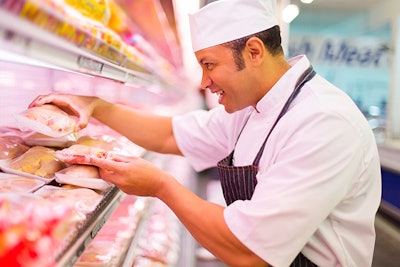
The February IRI shopper survey found that 90% of shoppers have noticed the price increases across the various grocery departments and 96% of those consumers are concerned about it. In response, 75% of consumers have already made one or more changes to their grocery shopping. Additionally, consumers are pulling back on restaurant visits not as much because of COVID-19 but as a means to save. Consumers are estimating that 82% of their meals in a typical week are prepared at home.
The average price per pound in the meat department across all cuts and kinds, both fixed and random weight, stood at $4.42 in February 2022, up 12.2% versus February last year. Inflation is a little milder when looking at the full 52 weeks ending February 27, 2022, with an average price per pound of $4.14, up 8.3%. Fresh meat has experienced above-average inflation especially in recent months compared to other areas of the store.
On the fresh meat side, virtually all proteins saw price increases in the double-digits when compared with February 2021. The notable exception remained fresh exotic meats, including bison and venison, only up +3.7% in price per pound. The increases trended very similarly on a per unit and per pound basis.
The U.S. consumer price index increased 7.9% for the 12 months ending February 2022. This was the largest 12-month increase since July 1981, according to the Bureau of Labor Statistics. IRI-measured multi-outlet stores, including supermarkets, club, mass, supercenter, drug, military, and other retail food stores, also showed continued price inflation over and above the elevated 2020 and 2021 levels. In February 2022, the average price per unit across all foods and beverages was up +10.3% versus the same weeks in 2021 and +16.8% versus February 2020. This means continued acceleration in the rate of inflation since the fall of 2021.
For the latest 52 weeks ending February 27, 2022, prices increased +6.0% — pulled down by much milder inflation in the second quarter of 2021.
IRI and 210 Analytics have teamed up since March 2020 to document the ever-changing marketplace and its impact on the meat department. The monthly analysis is made possible by Marriner Marketing.
Meat volume sales stay strong
Importantly, when removing the effect of high inflation, the retail supply chain continued to move more pounds through the system in February 2022 as shoppers bought more when compared to February 2020 (+3.3%).
The increase in home-prepared meals in the past two months, as documented in the IRI shopper survey, have resulted in strong dollar and volume performances. While pound sales were down versus year ago, they still exceed the February 2020 levels by +3.3%. Dollars have consistently exceeded 2020 levels by +20-23%. It is important to note that many packer/processors are unable to meet the retail order volume.
What’s next?
The marketplace disruption caused by inflation and supply chain challenges is not showing signs of letting up any time soon.
- At this time, inflationary levels have much greater impact on grocery shopping patterns than COVID-19 with 90% aware of the price increases and 96% extremely concerned, according to the IRI shopper research. This compares to only 31% of people being extremely concerned over Coronavirus as of February 2022.
- 45% of shoppers stocked up on certain items in February. Twenty percent did so as they were concerned it may not be available during future trips and 16% because they believe prices may be higher during their next visit.
- 81.7% of meals in February were prepared at home. This remains well above the July 2021 low of 77%.
- Nearly one-third of Americans, 32%, expect that their financial situation one year from now will look a little or a lot worse than it does today, whereas 45% believe it will be the same.
- 13% of trips were online in February, led by curbside pickup — which means 87% of trips were in-store, emphasizing the important role of produce in leading store choice. Only 4% of shoppers exclusively buy groceries online.
The next performance report in the IRI, 210 Analytics and Marriner Marketing series will be released mid-April to cover the March sales trends.
Please thank the entire meat and poultry industry, from farm to store, for all they do.

















